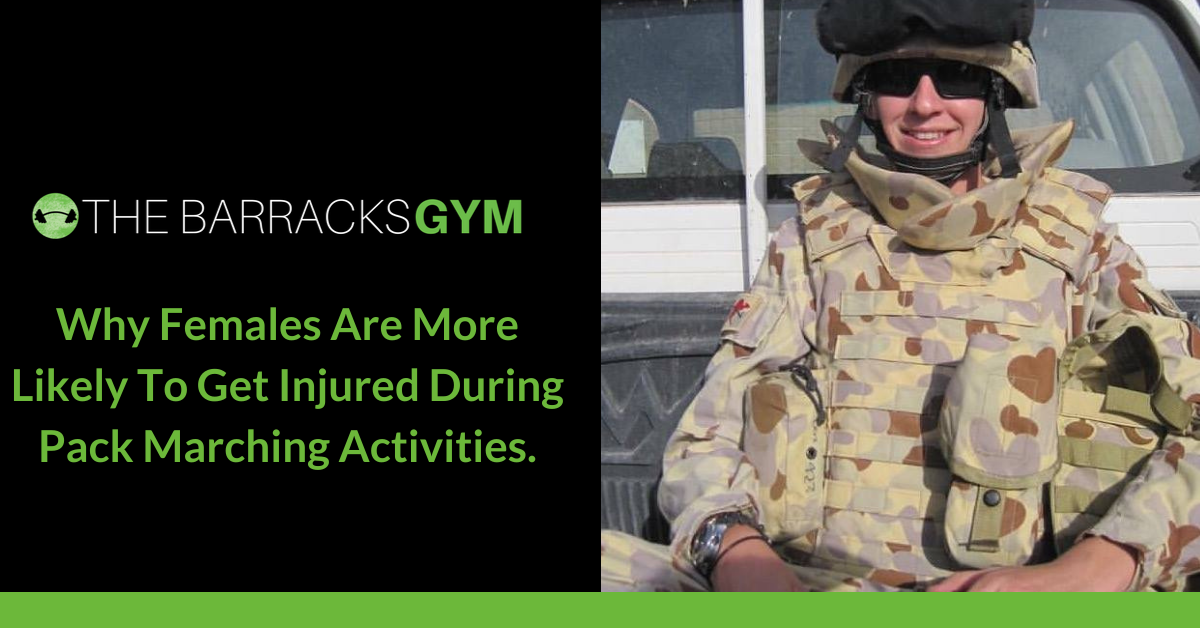|
Ever wondered why females are more likely to get injured than males when it comes to pack marching and wearing armour in the ADF? Below we highlight the main concerns, drawn from years of research, such as physiological factors including body fat mass, strength and aerobic endurance, as well as biomechanical factors and poor nutrition intake to raise awareness for the increased injuries risks for the female members of the ADF during load carriage activities. Load Carriage - Is defined as carrying external loads for job requirements in the ADF. This can include wearing webbing, carrying a weapon, wearing armour and also pack marching.
1. BODY FAT MASS Higher body fat percentages of greater than 21% can have an impact on endurance based activities. Research suggests that higher body fat percentage will reduce performance on lower intensity and longer duration activities such as prolonged walking ie. pack marching. 2. STRENGTH AND AEROBIC ENDURANCE Studies have found that although your fitness will increase throughout basic training, injury rates are higher at the commencement of training. The most common of these injuries are lower back followed closely by foot injuries for females. Both of these concerns can be mitigated through a progressive overload conditioning program (relevant fitness training). Secondly, through further research, it has been observed that an increase in aerobic capacity was the most highly and significantly correlated variable with improved load carriage performance. 3. BIOMECHANICAL FACTORS
This concept highlights the following three risk factors associated with female athletes. Alone or in combination these three factors pose a significant threat to females in the military due to the physical demands of service.
5. ADDITIONAL NUTRITION CONCERNS Even when females consume enough food to meet the daily energy requirements they may still not be meeting the daily iron intake requirements. Iron is essential for haemoglobin production. Low haemoglobin production reduces the ability of the body to transport oxygen in the blood to the working muscles. Research has shown that even mild iron deficiency can impair cognitive function and clear thinking. Load carriage has also been found to impact vigilance and alertness. Combining these two factors has an obvious impact on a soldier’s ability to notice visual clues of an enemy’s presence. 6. URINARY INCONTINENCE (UI) & PELVIC FLOOR MUSCLE (PFM) FUNCTION Female soldiers have reported to experience urinary incontinence (wetting your pants) during heavy load carriage activities. There is a defined link between PFM function and spinal stabilisation. In a nutshell, weak pelvic floor muscles combined with weak abdominal muscles and poor diaphragmatic breath control can equal UI. Learn how to breathe using your diaphragm, understand where and how to control your pelvic floor muscles and do some side planking!! In some cases females have even gone to the extent of reducing fluid intake as a way of reducing the likelihood of wetting their pants (UI). This is not recommended as it will lead to other potential risks such as heat illnesses. 7. POOR EQUIPMENT FIT It is no secret that females have often had troubles with the issued equipment. Problems with the pack fit, shoulder strap fit and also the waist belt position. Often females have raised concerns of feeling uncomfortable with restrictions in breathing due to the armour designs not accommodating breast tissue. Research and studies are in place to determine the most suitable approach however mission purpose and combat effectiveness need to supersede comfort concerns. SUMMARY In summary there are several concerns that could lead to a heightened risk of injury during load carriage activities in the ADF. These concerns have been around since 800BC when huge armies marched for hundreds of km's to battle carrying their shields spears and swords along with enough food and supplies to last them the months away but now, it's your concern. The things you can control are, ensuring your nutrition is in check whilst maintaining a healthy body fat percentage. And follow a relevant training program so that your strength and cardio endurance are constantly improved upon. The best thing you can take away from this is to ensure you are in peak shape at all times to deal with the rigours of load carriage throughout your military career. If you would like more advice on improving your load carriage fitness for the ADF then please feel free to get in touch with The Barracks Gym. All research is credited to Dr Rob Orr and the team from the Tactical Research Unit at Bond University and his affiliates at the University of Queensland and Charles Sturt University.
0 Comments
Leave a Reply. |
Most PopularTrusted PartnerWe work with the best service provider for Defence and First Responders.

Get SocialCategoriesArchives
January 2024
|
© COPYRIGHT 2024. ALL RIGHTS RESERVED.


 RSS Feed
RSS Feed